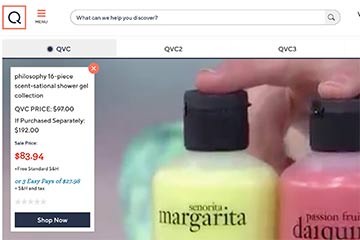Small and mid-sized ecommerce businesses can use live streaming to sell like QVC and HSN, introducing and demonstrating products as well as providing helpful content. And deploying live streaming now can take advantage of consumers’ new, pandemic-driven buying habits.
First, a little background.
QVC and HSN (formerly Home Shopping Network) are multichannel merchants with a history of broadcasting product pitches. HSN and QVC started sharing products on American television in, respectively, 1982 and 1986. Both now sell via several channels, such as social media, the companies’ websites (via live streaming), and television.

QVC is a multichannel merchant selling on its site, via television, and on social media.
Ecommerce retailers, no matter how small, can adopt similar tactics, offering a blend of QVC-or-HSN-like salesmanship and useful content marketing.
The technology behind live streaming is not new. But now, because Covid-19 has changed retail, merchants could garner more benefit from live streaming than was previously possible.
Covid-19 Impact
“Covid has escalated everything,” said Daniel Mayer, CEO of Be.Live, a company that facilitates live streaming. “In my view, it escalated things in years. We jumped three years ahead, five years ahead…and we are watching huge trends that were here. We need to mention that it’s not like a trend that the world is not familiar with. If we consider China, we would see that this trend [using live streaming for ecommerce] has been there for like 10 years — and if we are watching Asia, they are selling everything in live shopping.”
“When it comes to the U.S.,” Mayer continued,” it is just the beginning of the trend.”
The idea is that eventually, many retailers in the United States would have figured out that they could leverage their followings on Facebook, as an example, to share products via live streaming.
New Shopping Habits
Mayer’s point is that this year’s coronavirus pandemic sped up the trend as many online and brick-and-mortar sellers sought to find new ways to connect with customers.
This makes sense because shopping, in many ways, is a habit. It’s one of the points that author Charles Duhigg makes in his book, “The Power of Habit: Why We Do What We Do in Life and Business.”
Duhigg notes that life events impact our shopping behavior. Pregnancy, “changing residence, getting married or divorced, losing or changing jobs…are life changes that make consumers more ‘vulnerable to intervention by marketers.’”

Beautiful Disaster Clothing is an example of a brand that uses live streaming to engage its social media audience.
The current pandemic is just such a life-changing event. So it makes sense that shoppers are creating new buying habits and that marketers should work to help establish those habits in a way that is favorable for their stores.
“Live shopping is providing a new experience, and people feel that it is somehow like the offline experience,” Mayer said. “It is providing them the confidence [to make purchases]. It is providing them with lots of trust. [It gives shoppers] the ability to ask questions, the ability to speak with the seller, the ability to watch the community providing their reviews of the specific product on the live show.”
In the coronavirus context, live shopping may help fill a void and could be habit-forming.
What’s more, the technology to produce an ecommerce live stream is not expensive or complicated.
Be.Live, Mayer’s company, is one example. But other providers include Ecamm, Restream, and StreamYard, as well as native live-streaming capabilities on social media platforms.
Connecting with Consumers
“Live streaming is about authentic connections and can be a powerful way for ecommerce businesses to get their message out to consumers and potential consumers,” said Katie Fawkes, a digital marketing manager with Ecamm.
“Depending on the business’s branding, it can leverage live streaming for selling products — a live stream flash sale, for example — sharing behind-the-scenes content, [such as] how a product is made, what the vibe is in the office, or among different team members, or even thought leadership. A shoe ecommerce business, for example, could do a weekly live show sharing about their ethical sourcing methods and how that’s having an impact in the world.
“Consumers buy from businesses they know, like, and trust,” Fawkes continued. “An ecommerce business should look to their target audience and see what kind of content would matter most to that group…this could be a variety of things from live-streamed sales, to interviews with industry experts, to behind-the-scenes, and more. Remember, although every live stream broadcast is in itself impactful, it can also be repurposed and used in all aspects of larger marketing efforts.
“The most important part is for ecommerce businesses to be thinking past their products and focusing on the ‘why’ and the story that matters to their consumers.”







